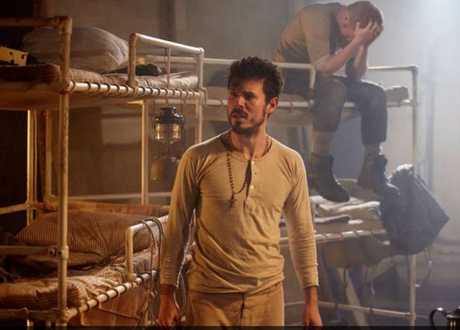
The Sea Plays at the Old Vic Tunnels.
Sailing the stormy seas seems an archaic career path these days, one that doesn’t feature much in contemporary stories, apart from news reports of Somali pirates or daring solo adventures. However, director Kenneth Hoyt’s production of three of Eugene O’Neill’s one-act “Sea Plays” in the Old Vic Tunnels compellingly brings the historic experience of seafaring to life, and in a suitably claustrophobic, clanking, rumbling setting beneath the train tracks of Waterloo.
O’Neill, great American playwright of “Long Day’s Journey Into Night,” wrote “The Sea Plays” between 1914 and 1917 at the outset of his writing career, shortly after returning from a few years of seafaring labor. The sea features in much of his later work, and these plays, as brawny as they are briny, give a strong indication of his Pulitzer- and Nobel-winning work to come.
These are muscular plays, in every sense. The danger of storms frames poignant, engrossing dramas of fatal injuries, wartime paranoia and dockside treachery. A sailor shovelling coal into a flickering furnace at the entrance to the theater and the swirling opening choreography of the first play, “Bound East for Cardiff,” places the audience firmly on board: in the burning engine room, on the water-sloshed deck, in the cramped sailors’ quarters within the hull. It is a heavily male, physical world, with plenty of oiled and rippling torsos on display. (Perhaps we should revive the profession, after all.)
The cast is strong, dynamically embodying characters courageous and craven, hopeful and lost. Some characters appear more than once; although each play stands alone, they are connected by the fictional ship of their setting. (“The Sea Plays” are also known as “The Glencairn Plays,” after the name of the ship.) While the first two plays, “Bound East for Cardiff” and “In the Zone,” take place in the sailors’ living quarters, the final “Long Journey Home” occurs in a shady bar close to the ship’s port, showing that perils lurk on land as much on the waves.
All three plays are highly entertaining and moving, examining not only the physical hardships but moral dangers of an intense, confined existence at sea. They bring to life a long-gone era of gas-lamps and clanging metal, dry rations and sloshing ale, dockside whores and lurking thieves. It’s a rich, full-blooded world, and the plays are still relevant for their dramatic power and human insight almost 100 years later.
Though O’Neill loved the sea, there can be little doubt that he found his time working on ships arduous. The alcoholism and depression he suffered during those years crops up in an autobiographical detail of “In the Zone,” in which a character’s drinking forms the “black shadow” overhanging his lost love.
The Swedish protagonist of “The Long Voyage Home,” who has saved two years’ pay to retire from seafaring and return to his family farm for good, speaks of working the land with wistful nostalgia and expresses horror at a dangerous Cape Horn voyage, which makes his fate all the more dreadful. The injured sailor in “Bound East for Cardiff” knows he won’t make it to shore alive and seems to regret his inevitable sea – rather than land – burial more than death itself. None of O’Neill’s sailors love their dangerous endeavours: “hard work for low pay,” as one bluntly states.
Perhaps this predicament of working to survive will resonate most with contemporary audiences, despite the antiquated seafaring context. In that respect, many people, like O’Neill’s sailors, must continue to navigate rough waters, dreaming of dry land.
The Sea Plays are on at the Old Vic Tunnels through 18 February.

